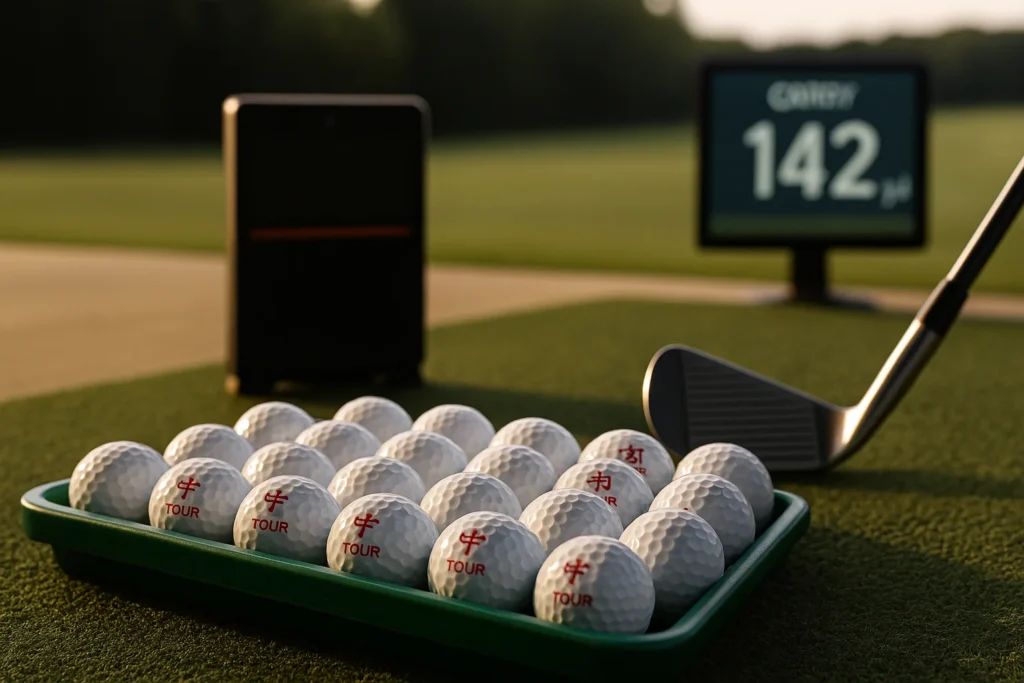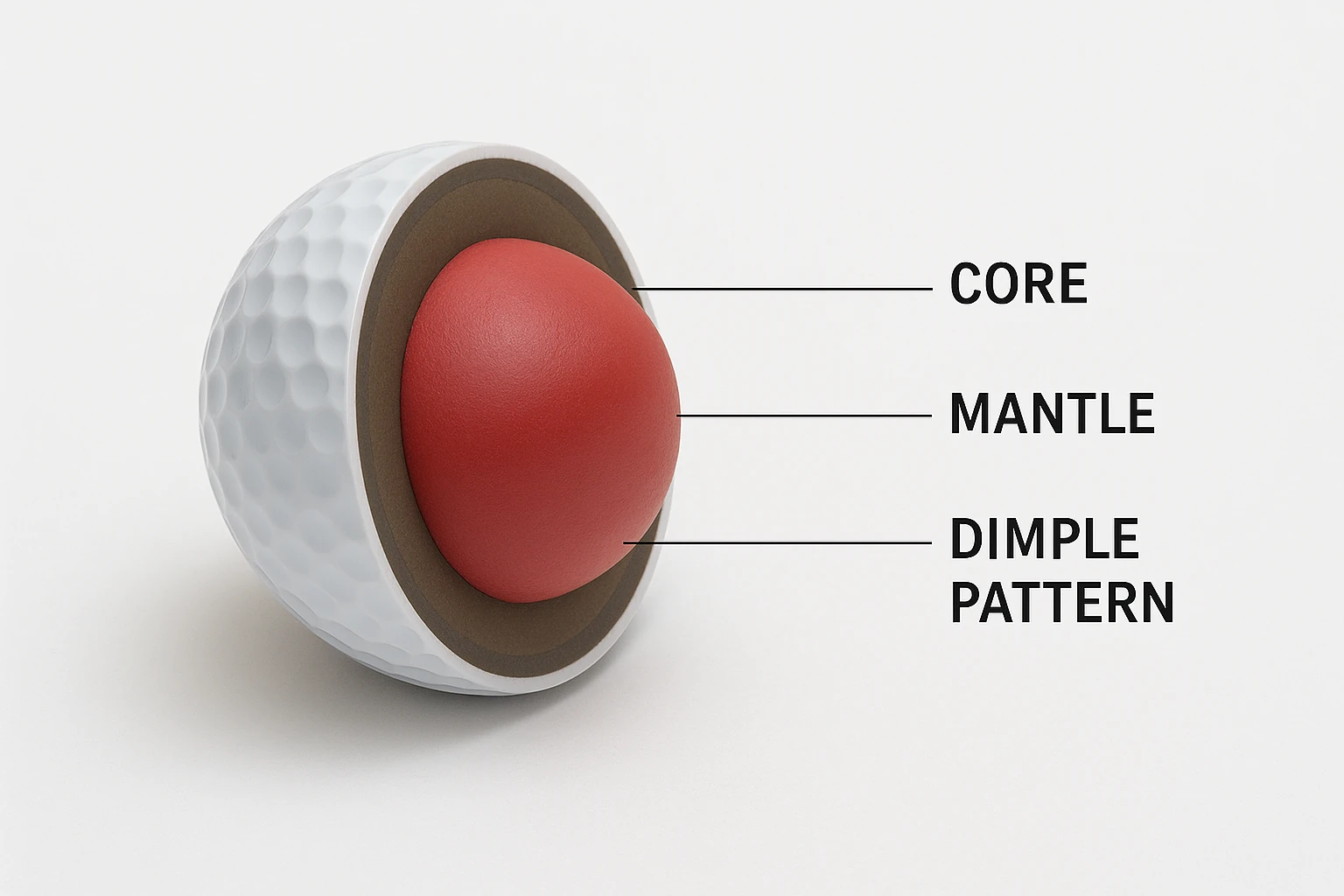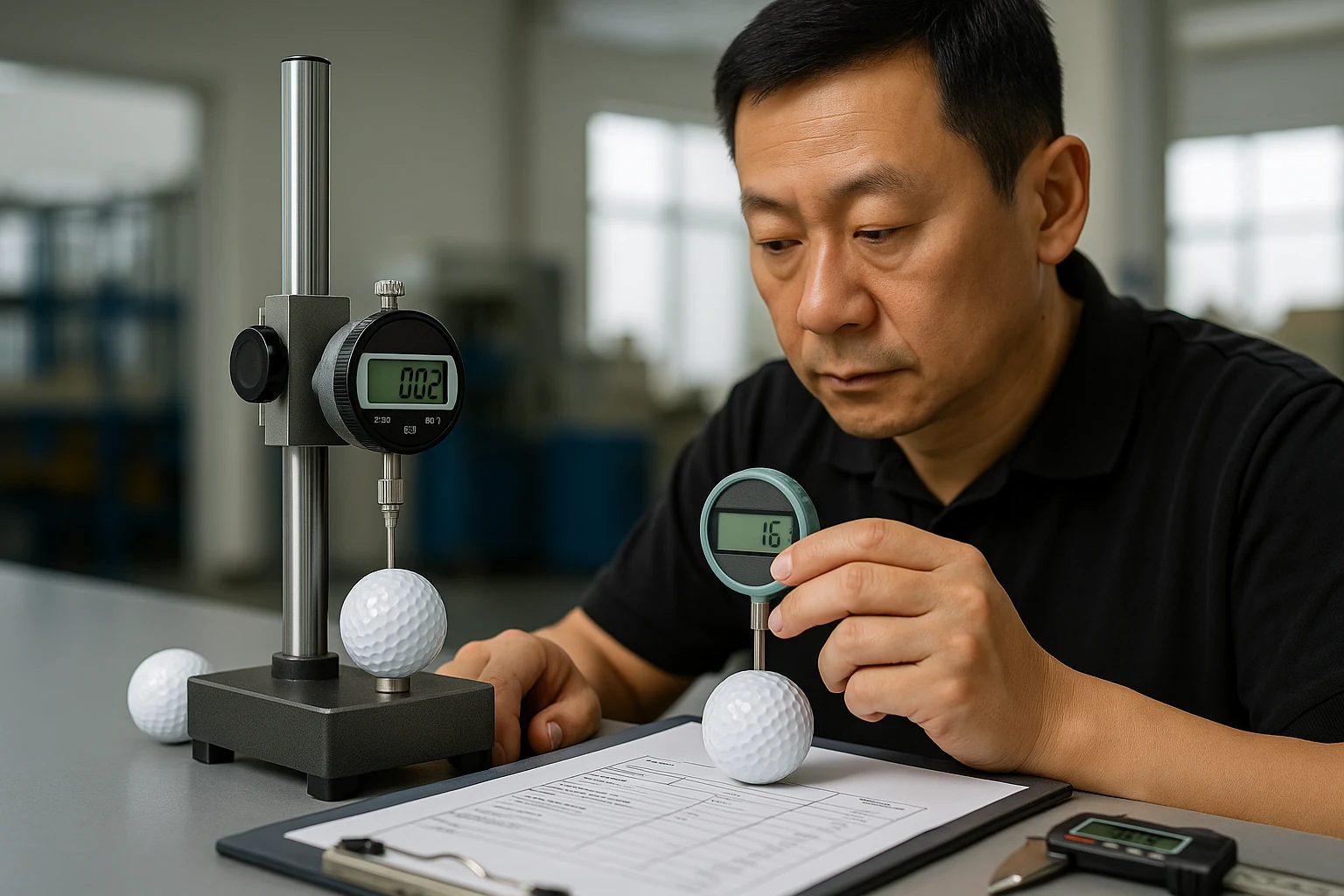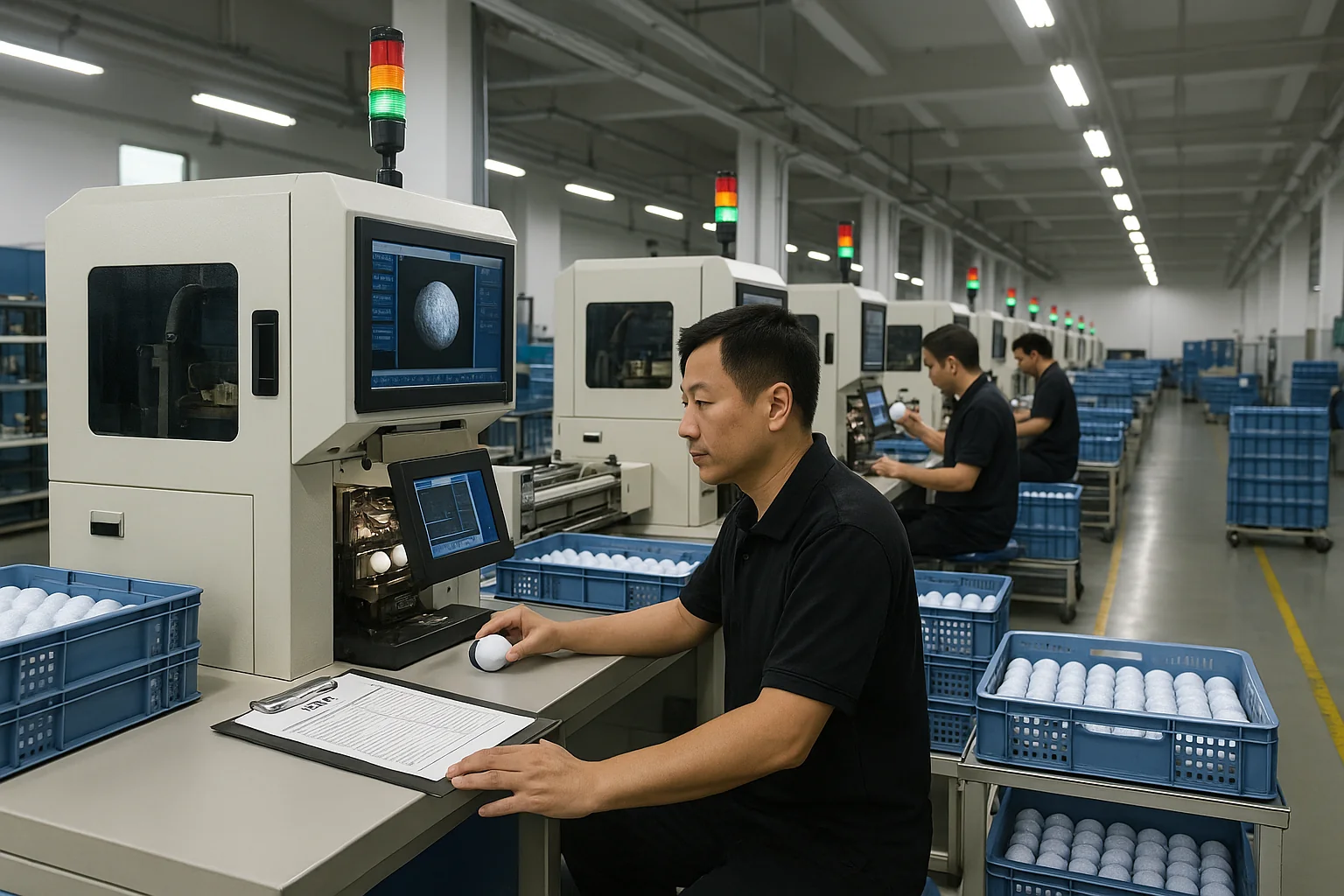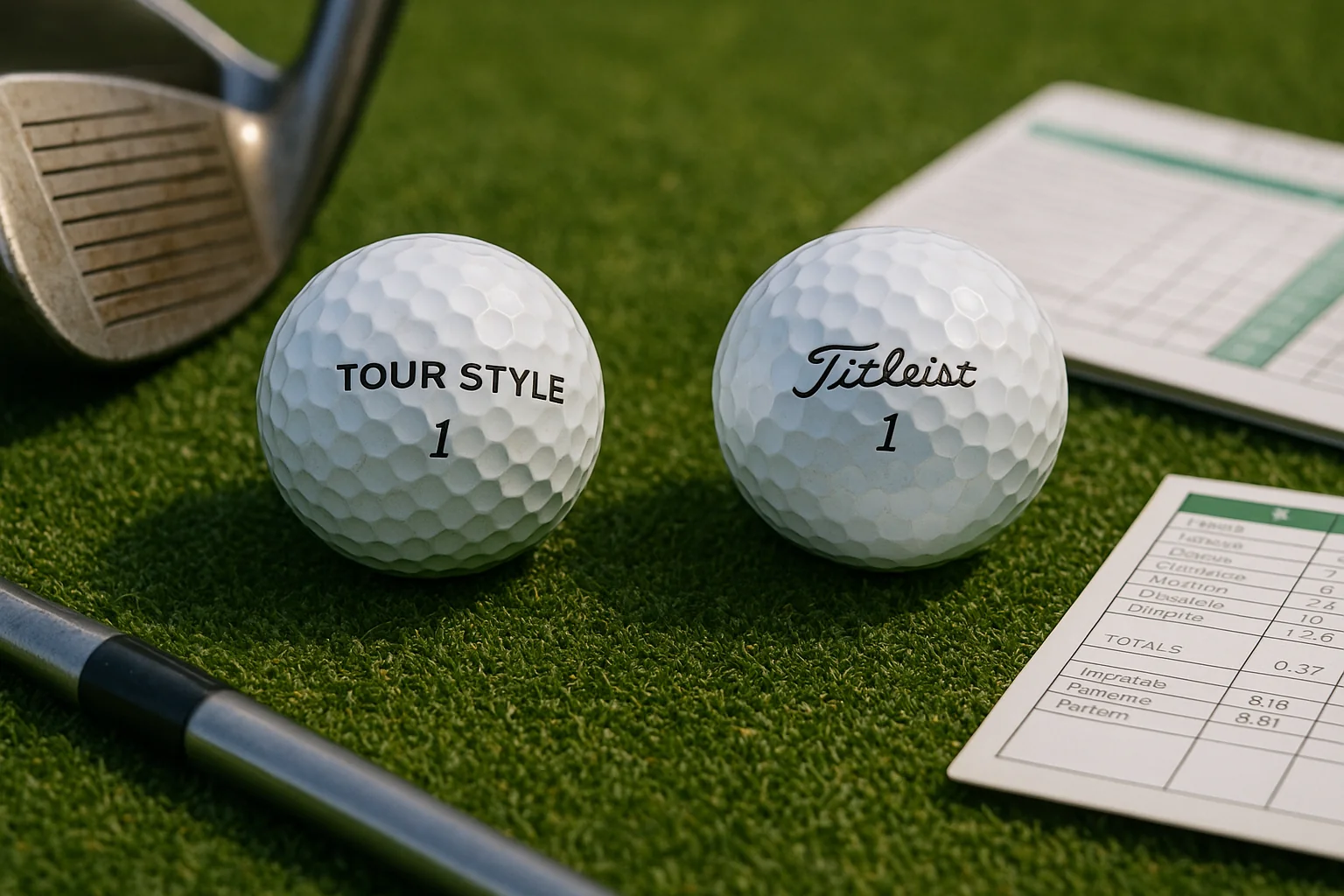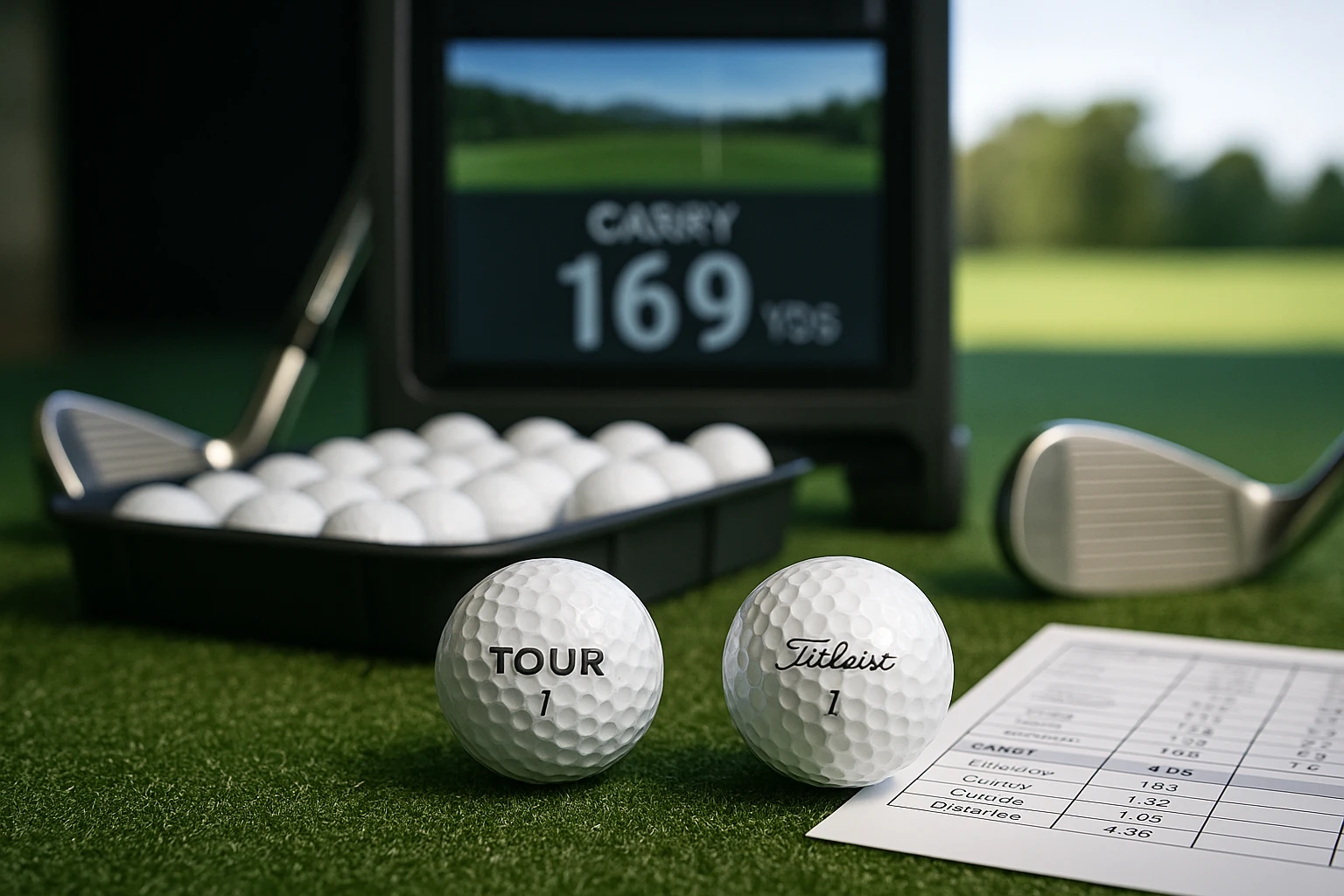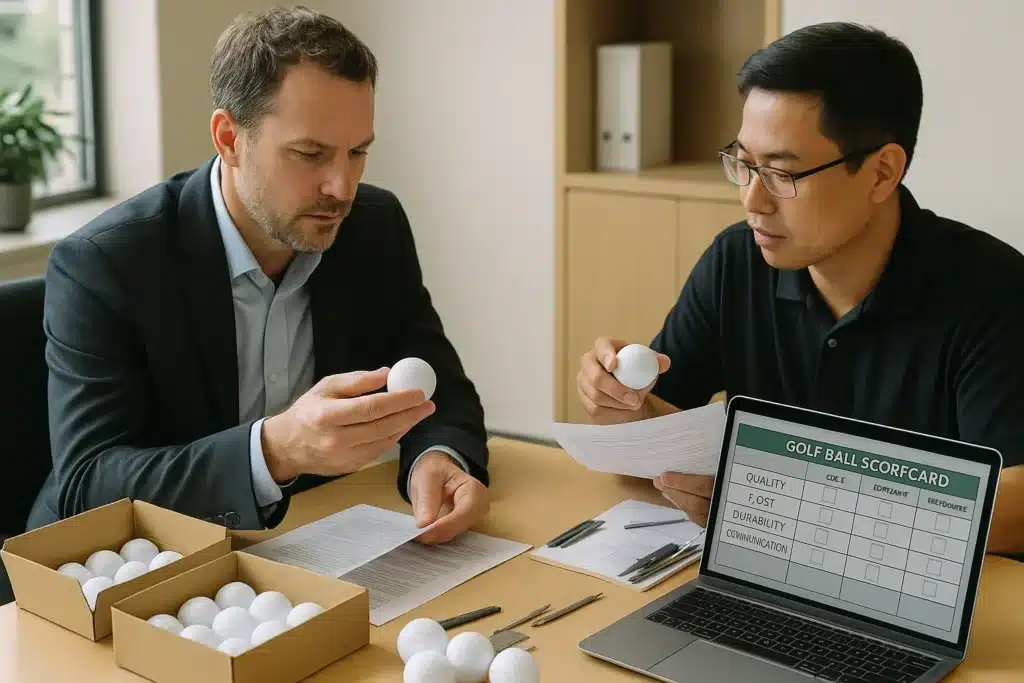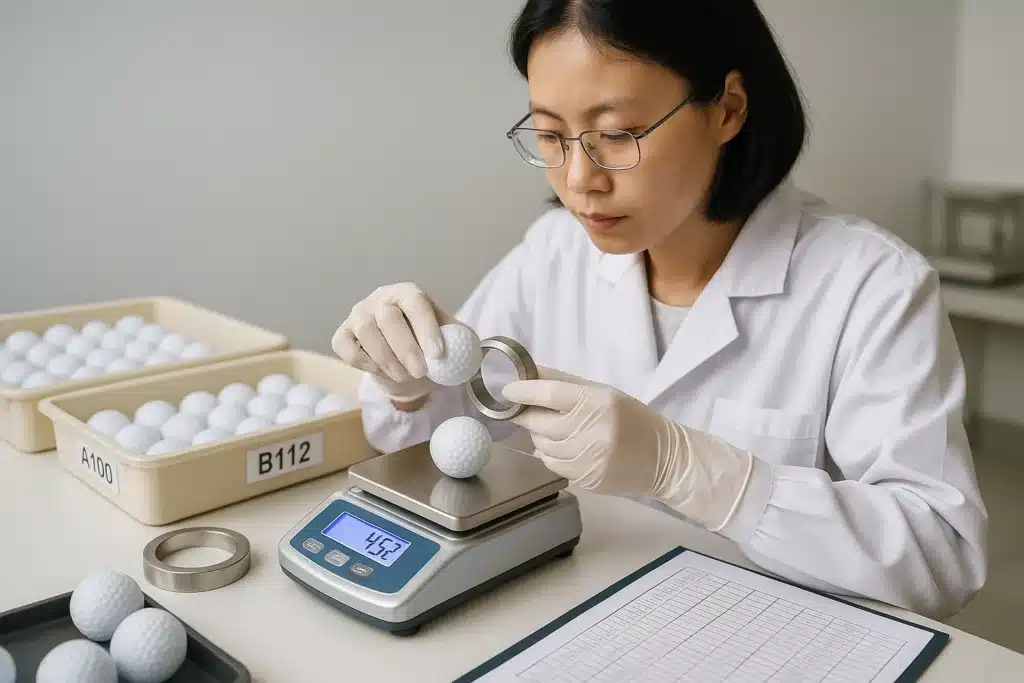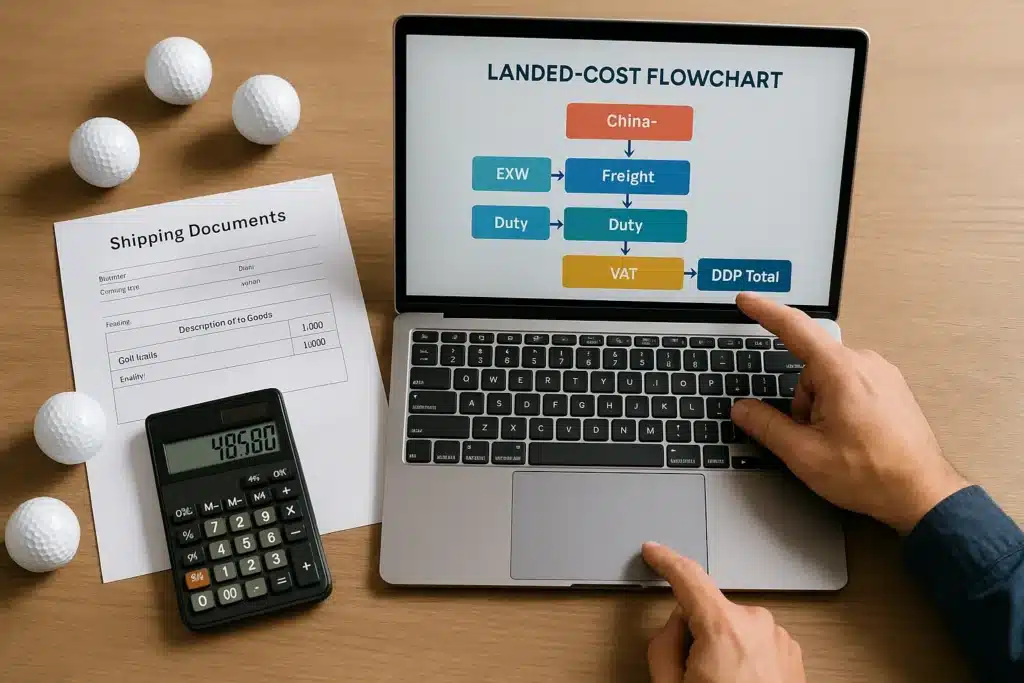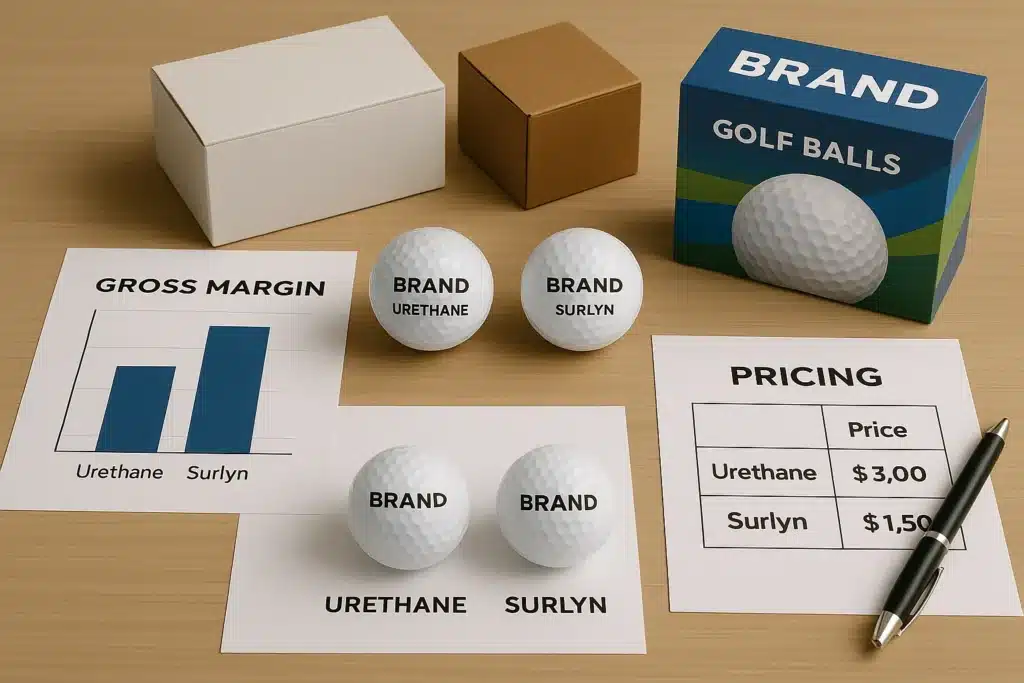Introduction
Chinese factories make multi-layer balls marketed as Tour-grade, but performance averages about 70% of true Tour level; cast-urethane Tour-grade production—and the best spin, feel and consistency—remains dominated by plants in the US, Thailand, Korea and Taiwan.
Key Takeaway: China excels in Surlyn/TPU mid-tier; true Tour-grade cast-urethane output still led by US/TH/KR/TW; expect ~70% performance.
What Is a Tour-Grade Golf Ball?
A Tour-grade golf ball is a multi-layer urethane-covered ball that meets strict USGA/R&A standards, designed to deliver elite spin, consistency, and control for professional play.
Who Uses Tour Balls?
Tour balls are built for players who turn proximity into strokes gained: professionals, elite amateurs, and serious golfers who value predictable spin, tight dispersion, and repeatable launch windows across the bag.
These players need greenside “bite,” mid‑iron stopping power, and stable trajectories in wind. If your goals include scoring in competition or protecting premium brand reputation in pro‑shop retail, Tour-grade golf balls make sense. For developing golfers, a proper ball‑fitting can still point to Tour models when delivery, land angle, and wedge control outscore raw distance.
Key Performance Features
Tour-grade golf balls combine low driver spin with controlled iron spin and high wedge friction, separating long‑game speed from short‑game stopping.
The urethane cover interacts with grooves to raise spin on partial shots and chips. Multi‑layer cores and mantles tune compression for speed without ballooning. Aerodynamic dimple lattices—often tetrahedral—keep the ball penetrating through gusts. Together, these features lower scoring through predictable apex, descent angles, and run‑out control.
Why They Cost More
Costs climb because cast urethane is slow, precise, and unforgiving, and the QC stack is intense.
Cast thermoset urethane is reacted in the mold to exact thickness and hardness. It delivers feel and friction that TPU or Surlyn struggle to match. Each step—core mixing, mantle bonding, cover casting, painting, stamping—introduces tolerance risks, so premium factories run dozens to over a hundred checkpoints. Tooling, yield loss, and cycle times raise the unit price, but they also narrow performance variance.
Compliance & Market
Tour-grade golf balls must conform to USGA/R&A (United States Golf Association / The R&A) rules (≤45.93 g; ≥42.67 mm; symmetry and distance) and appear on the monthly conforming list used by events under Model Local Rule G-3.
In the market, flagship models retail around $45–$55 per dozen, with Titleist Pro V1/Pro V1x, TaylorMade TP5/TP5x, Callaway Chrome Tour/Chrome Tour X, Bridgestone Tour B, and Srixon Z‑STAR lines setting the benchmark for professional play and premium B2B placements.
📊 Table 1 – Tour vs Entry-level Balls
Use this comparison to choose performance tier; prices shown per dozen. On mobile, swipe horizontally to view all columns.
| Feature | Tour-level (Urethane, 3–5 layers) | Entry-level (Surlyn, 2-piece) |
|---|---|---|
| Short-game spin | High, soft | Low, firm |
| Driver spin | Low–mid | Very low |
| Durability | Medium | Very high |
| Price | $45–$55 per dozen | $15–$40 per dozen |
| Audience | Elite/pro | Beginners, practice use |
✔ True — Tour balls are about spin and control
Tour-grade balls are not automatically longer. Their advantage is spin and consistency, especially around the green. Amateurs often assume distance gains, but real benefits depend on fitting and skill.
✘ False — “Tour balls always go farther”
Distance is often similar to entry-level balls. Control and spin are what make Tour balls elite.
Key Takeaway: Tour-grade balls use urethane covers, multi-layer cores, and tight tolerances to deliver elite spin control, consistent flight, and USGA/R&A-compliant performance.
Can Chinese Manufacturers Make True Tour-Grade Balls?
Chinese factories produce high-quality Surlyn and TPU balls, but they cannot yet mass-produce cast urethane Tour-grade models due to technology, patents, and QC limitations.
Why the Gap Exists
The gap is a compound of materials IP, casting equipment precision, and tolerance discipline that must hold across millions of spheres.
Cast thermoset urethane demands narrow temperature, reaction, and demold windows. Mantle hardness and core centricity must stay within extremely tight bands. Even with the same machine nameplate, recipe knowledge and process control separate average output from Tour‑level repeatability. Until local plants master cast chemistry and sub-±0.02 mm geometry, the gap will persist.
China’s Golf Ball Industry Landscape
Production clusters in Guangdong, Zhejiang, and surrounding provinces serve practice ranges, logo programs, and value retail with 2–3 layer Surlyn and some 3–4 layer TPU builds.
These factories excel at volume, price, and lead time. Some run partial urethane projects, but most “urethane” claims on spec sheets translate to thermoplastic urethane rather than true cast thermoset covers associated with top Tour models. Packaging and printing sophistication is high; cover chemistry precision is where the road narrows.
📊 Table 2 – Chinese OEM vs Tour Balls
Contrast Chinese OEM focus versus Tour demands; prices shown per dozen. On mobile, swipe horizontally to view all columns.
| Dimension | Chinese OEM Products | Tour-level Balls |
|---|---|---|
| Layers | 2–3 (some 4) | 3–5 |
| Cover | Surlyn / TPU | Cast urethane |
| Process | Injection/compression | Cast molding |
| Tolerance | ±0.05–0.1 mm | ±0.01–0.02 mm |
| Price | $5–$15 per dozen | $45–$55 per dozen |
✔ True — TPU is not cast urethane
Some suppliers advertise urethane covers, but most use TPU. Cast thermoset urethane, as in Pro V1 or TP5, delivers superior spin and feel. Buyers must confirm cover type before assuming Tour-level quality.
✘ False — “All urethane covers are the same”
Not all urethane is equal. TPU cannot match cast thermoset urethane’s performance.
Current Market Focus
China’s sweet spot today is price‑stable supply for ranges, academies, promotions, and e‑commerce bundles where durability and cost per round beat elite wedge spin.
You’ll find robust two‑piece Surlyn balls, three‑piece TPU builds with eye‑catching sleeves, and fast turnaround on logo programs. For B2B buyers, this means consistent replenishment, workable MOQs, and accessible custom packaging. It does not, however, mean tournament‑grade greenside control or the sub-±0.02 mm repeatability demanded by Tour models.
Future Potential
Breaking through requires true cast urethane capability, better mantle chemistry, and production metrology that tightens every tolerance loop.
Investments are already flowing into higher‑precision molds, inline vision systems, and smarter process control. When a factory proves it can hold urethane thickness, core centricity, and paint durability while passing conformity month after month, it will earn a seat in the Tour-grade supply chain. Until then, Chinese manufacturers should own the mid‑tier and expand responsibly toward the top.
Key Takeaway: Not yet at scale: China makes quality Surlyn/TPU models, but lacks cast-urethane capability and ±0.01–0.02 mm repeatability required for true Tour-grade.
How Close Are Chinese “Tour-Style” Balls to Tour Level?
Chinese “Tour-style” balls resemble Pro V1 or TP5 but typically achieve only 60–75% of Tour-level performance, especially lacking in greenside spin, feel, and consistency.
What They Look Like
Appearance is convincing—similar dimple counts, glossy paint, sharp pad prints, and premium sleeves—but cosmetic parity can mask meaningful material and tolerance gaps.
Many “Tour-style” models mirror five‑sided or tetrahedral dimple motifs and market urethane terms liberally. In the hand they feel fine; in testing they show higher compression, wider weight spread, and covers that scuff sooner. For corporate gifting or range use, looks matter; for elite scoring, the chemistry beneath the ink does the real work.
Performance Gaps
-
Lower cover–groove friction reduces partial‑shot spin and check.
-
Wider compression/weight spread increases dispersion on approach.
-
Paint systems scuff sooner, raising replacement costs per round.
-
Wind robustness fades on half‑shots, producing unexpected curvature.
📊 Table 3 – Chinese “Tour-style” vs True Tour Balls
| Aspect | Chinese “Tour-style” | Pro V1 / TP5 |
|---|---|---|
| Driver distance | Comparable | Optimized, consistent |
| Iron spin | Lower | Stable & precise |
| Short-game spin | Noticeably lower | High Tour-level spin |
| Feel | Firmer, less refined | Softer, premium |
| Durability | Wears quickly | Long-lasting |
| Batch consistency | ±0.05 mm | ±0.01 mm |
✔ True — “70% of Pro V1” is a practical estimate
The claim that Chinese balls reach 70% of Tour standards is an estimate based on testing. Performance varies by batch, making them unreliable for competitive play.
✘ False — “They’re officially rated at 70%”
There is no official certification. The figure comes from comparative testing, not governing bodies.
Why Closing the Gap Is Hard
Materials are locked behind patents and know‑how, casting is capital‑intensive, and QC cultures take time to mature—none of which can be rushed by buying one more machine.
Thermoset urethane formulations, catalyst ratios, and post‑cure schedules are guarded. Multi‑axis molds must hold micro‑tolerances. Inline measurement must catch sub‑visible defects before paint hides them. Achieving repeatability is a multi‑year journey, not a one‑off upgrade.
Buyer Takeaway
Use Chinese Tour-style balls for casual golf, training programs, and promotional kits; reserve Tour-grade for competition, college programs, and elite retail where consistency and spin are non‑negotiable.
If you need conformity for events, verify the monthly list. Build your sourcing brief around the playing context first, then choose cover type, layers, and tolerance windows that fit outcomes and budget.
Key Takeaway: Appearance is similar, performance isn’t: most achieve only 60–75% of Tour level, especially weaker in greenside spin, feel, durability, and batch consistency.
How Does Titleist Pro V1 Compare to Chinese “Tour-Style” Balls? (1–10 Scorecard)
Compared to Titleist Pro V1, Chinese “Tour-style” balls score around 7/10 overall, performing well in driver distance but falling short in short-game spin, feel, and batch consistency.
How We Scored the Metrics
We used a 1–10 rubric anchored to Pro V1 for each category, then ran side‑by‑side sessions covering drivers, mid‑irons, wedge shots, wind holds, and durability checks across multiple rounds.
Data points included launch, spin, land angle, carry, rollout, and subjective feel corroborated by blind A/B chips. Batch checks sampled size/weight with calipers and scales and looked for scuffing after bunker play.
Where Do These Scores Matter On‑Course?
Driver parity hides the gaps that cost strokes: iron approaches roll out further, partial wedges release instead of checking, and gusts introduce surprise curvature at half swings.
Over 18 holes, that means fewer green‑in‑regulation conversions, fewer one‑putts, and more pressure on tee‑to‑green precision to offset lost up‑and‑downs. For elite play, those small deltas add up fast.
What Does This Mean for Procurement?
-
Specify cover type (TPU vs cast urethane) and mantle chemistry targets.
-
Set size/weight tolerances (target ≤ ±0.03 mm) and require COAs by batch.
-
Add pre‑shipment inspections including cut‑ball audits and wedge‑spin checks.
-
Document paint adhesion, abrasion resistance, and carton drop tests.
📊 Table 4 – Scorecard (1–10 scale)
| Metric | Titleist Pro V1 | Chinese “Tour-style” | Gap Analysis |
|---|---|---|---|
| Driver Distance | 9.0 | 8.0 | Close, sometimes straighter |
| Iron Spin | 9.5 | 7.0 | Rolls further on greens |
| Short-game Spin | 10.0 | 6.0 | Lacks greenside “bite” |
| Feel & Sound | 9.5 | 6.5 | Firmer, harsher |
| Durability | 9.0 | 7.0 | Coating wears faster |
| Consistency | 9.5 | 6.5 | More batch variation |
| Aerodynamics | 9.0 | 7.0 | Less stable in wind |
| Overall | 9.5 | 7.0 (~70–75%) | Clear short-game gap |
✔ True — Chinese balls are fine for casual use
Chinese Tour-style balls may perform adequately for casual golfers, practice ranges, or corporate gifts. But professionals require the precision of Tour-grade consistency.
✘ False — “They’re tournament-ready”
Many Chinese Tour-style models are not present on the current USGA/R&A conforming list. Always verify the exact model and month before any event under Model Local Rule G-3.
Key Takeaway: Scorecard shows ~7/10 overall for Chinese Tour-style balls: driver distance close, but short-game spin, feel, wind stability, and consistency trail Pro V1.
What’s the Bottom Line for Buyers?
Chinese factories excel in entry and mid-level balls with strong cost advantages, but genuine Tour-grade production remains concentrated in the US, Thailand, Korea, and Taiwan. Buyers may source Chinese “Tour-style” balls for recreational or promotional use, but not for elite competition.
What Should B2B Buyers Do Next?
Define your scenario (competition, academy, or promotion) first, then backsolve into cover type, layer count, tolerances, and conformity requirements that protect your outcome.
If a tournament invokes MLR G-3, purchase listed balls only. For academies and ranges, prioritize durability, replenishment cadence, and carton tests. For retail, validate with small A/B pilots before scaling, and collect feedback from skilled players, not only beginners.
When Does a Tour Ball Make Sense?
Choose Tour-grade when greenside spin and iron control drive scores, or when your brand must align with premium expectations in elite venues.
For high‑handicap groups, Surlyn two‑piece saves budget without sacrificing driver distance. For mid‑handicaps who value feel, three‑piece TPU can be a pragmatic middle step. Always fit the ball: swing speed, launch, and descent angle decide whether Tour benefits appear.
How Should You Control Risk When Sourcing in China?
Freeze an approved sample, demand batch COAs, and add pre‑shipment inspections including cut‑ball audits and wedge‑spin spot checks.
Specify target tolerances (aim ≤ ±0.03 mm even if ±0.02 mm is not yet feasible), paint adhesion tests, carton drop tests, and humidity exposure. Align lead times to packaging proof approvals and holiday schedules. Keep a backup supplier for continuity, especially if your program relies on seasonal demand or event windows.
Key Takeaway: Use Chinese Tour-style for ranges, academies, and promos; choose Tour-grade for competition or premium retail; always verify USGA/R&A conformity and tolerance specs.
FAQ: What Else Do B2B Buyers Ask?
Can Chinese factories produce true Tour-grade golf balls?
They can manufacture multi-layer TPU/urethane designs that reach roughly 60–75% of Tour standards, but fully fledged cast‑urethane Tour models remain dominated by plants in the US, Thailand, Korea, and Taiwan.
Do Chinese balls fly as far as Pro V1?
Yes. Driver distance is often close and sometimes straighter due to lower spin and higher compression. The gap opens on approach and greenside shots where spin and land‑angle control matter most.
Can they be used in tournaments?
Many Chinese Tour-style models are not present on the current USGA/R&A conforming list. Always verify the exact model and month before any event under Model Local Rule G-3.
What’s the MOQ for OEM orders?
Expect 1000–2000 units for Surlyn/TPU projects depending on packaging and print complexity.
You Might Also Like: B2B FAQ: U.S. vs China Golf Ball Manufacturing

